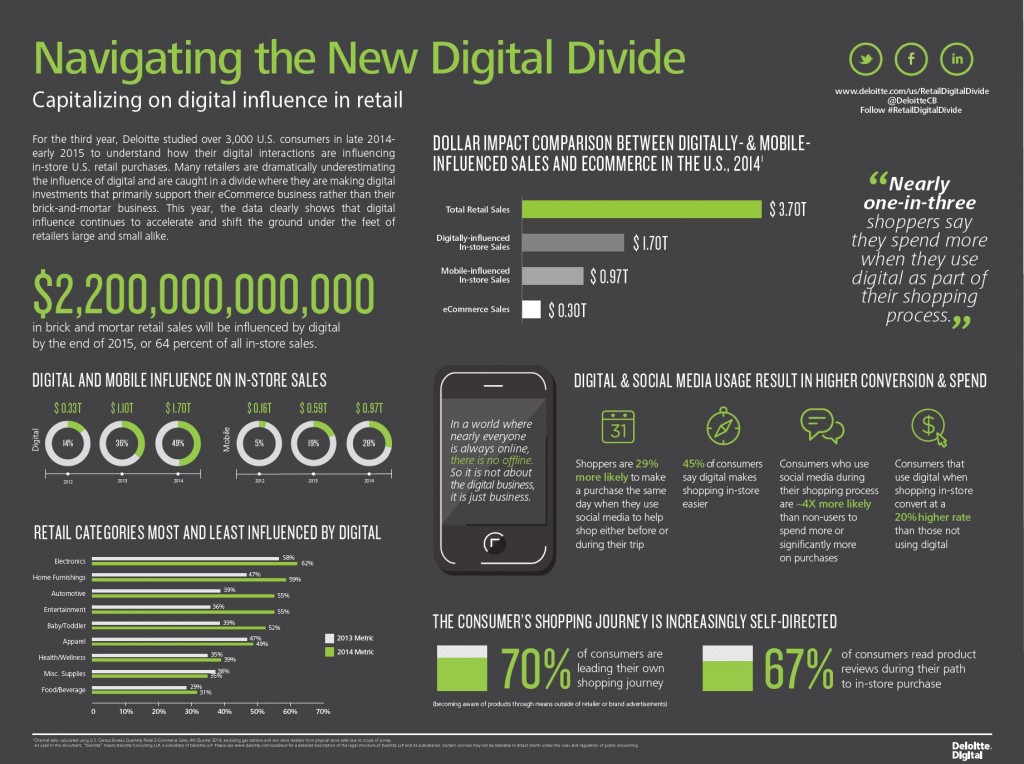Selling to the Socially Networked Customer
 The socially networked customer is one that asks Facebook friends whether they should invest in a Vitamix or a Blendtec. They might spend an extensive amount of time reading online product reviews to narrow down a hunt for the perfect knife. They walk into a store ultra-prepared. When on a shopping excursion, they possibly tweet about a new purchase or a bad experience.
The socially networked customer is one that asks Facebook friends whether they should invest in a Vitamix or a Blendtec. They might spend an extensive amount of time reading online product reviews to narrow down a hunt for the perfect knife. They walk into a store ultra-prepared. When on a shopping excursion, they possibly tweet about a new purchase or a bad experience.
Ultimately those customers who use social media during their shopping process are about four times more likely than non-users to spend more on purchases as a result of a digital shopping experience, according to a report by Deloitte Digital called “Navigating the New Digital Divide,” which studied over 3,000 U.S. consumers in late 2014 through early 2015. Digital influenced $1.7 trillion of in-store sales last year compared to just $0.33 trillion only a couple of years ago, according to the study.
So what do retailers do when this type of customer walks into their store? Bob Phibbs, CEO of The Retail Doctor, a retail consultancy based in upstate New York, says that making a sale goes back to training staff well to gain the upper hand with the well-researched customer.
“You have to have employees that can share the wisdom of why one is better than the other, and they can compare and contrast what someone may have found on a website,” says Phibbs. “They can still make the sale if they have taken the time to train people how to engage customers and how to build a relationship. I know that sounds old hat, but most people don’t know how to do those things anymore.”
This basic approach is especially important, Phibbs point out, because the dynamic between customers and retailers has changed. Customers can now surf the web and easily get information on specific products they are interested in, whereas employees must retain general knowledge on all the products throughout the entire store.
“In the old days, retailers had all the knowledge, and you had to trust somebody to know what they were talking about with that product,” says Phibbs. “The reality is there’s no employee that’s going to know everything about all of your SKUs, for the simple reason that the customer, when they do their shopping, has already limited everything down to a really tight search; so of course they know more than the employees.”
Greet these customers when they come into the store. Too many retailers take the approach of ignoring a customer who has a phone in hand while shopping, thinking that perhaps the customer is “showrooming,” or browsing in person to ultimately purchase online, Phibbs says. He urges retailers to make it a point to greet these customers and actually encourage them to use their phones in the store because it is a way for the retailer to get involved in the customer’s own social media use.
“You don’t want them to take a picture of just a product in your store,” says Phibbs. “They’re going to share it if it’s a picture of them with the product in the store, so you have to be willing to take it. And particularly, the younger the customer, the more that’s important. If somebody tried to do that with my mom who’s 90, she’d probably slug them and say, ‘Leave me alone.’ But if you’re 30 or something, that would be very important because they’re all shopping socially.”
Make product suggestions. The customer may have an idea about what they want to buy, but simply making a suggestion opens up more possibilities. This is especially important if the customer has already honed in on a product that you do not carry.
“I think most retailers go through and they pretty much just act like a warehouse. They wait for the customer to tell them they’re looking for the KitchenAid ultra power mixer in grape, then the employee says either they have it or they don’t by checking a computer, and they go get it off of the shelf, and they think they did a great job. Well, I think that’s the problem,” says Phibbs. “If you don’t add something, if you don’t go through and suggest something – let’s say if you don’t have the grape, but you’re able to talk to them about how the burgundy might go just as well, and it might be fun or something … If someone walked into your store today, the reality is, they want to buy it. Nobody’s walking into a store these days going, ‘Oh, I’m just going to check it out.’ They did that online. So the stakes have gotten higher for retailers.”
You don’t necessarily need a social media presence for your store, Phibbs says. Doing so requires time and effort to obtain the desired results, and many retailers cannot realistically achieve this alongside all the other responsibilities that are required of them as a small business owner.
“To do it right really takes a lot. I see too many retailers just give it over to their daughter or somebody and say, ‘You do it for me,’ and they don’t understand that just throwing a picture up on a Facebook page or tweeting something out isn’t really going to build a relationship. You really have to create a tribe, a community, and that takes a lot of work, I won’t kid you,” says Phibbs. “Too many people think it’s a replacement for a circular, or a coupon, and just throwing up a 20 percent-off coupon does not build any loyalty because there’s always somebody cheaper.”
If you do want to tackle social media, Phibbs suggests starting with one platform and mastering that one first. Facebook is a good place to start, he says, because people really do have conversations there and most of their friends will also be on the platform, plus Facebook offers the opportunity to place ads. Once you have picked the social media platform of your choice, schedule posts out ahead of time to make things easier. You could plan out all the tweets or Facebook posts for the upcoming week while having coffee on a Sunday morning. If you choose YouTube, then you might start by planning out five videos for the month. Try to avoid having posts from Facebook automatically also post to a Twitter account, or vice versa, because the two markets are actually very different and require different approaches to be effective, Phibbs says.
“Kitchen stores, I always think it’s interesting because you have so many gadgets,” says Phibbs. “Even if someone is just looking, they can pick up a $5 or $10 peeler or scraper, or something, if you would just be nice enough to get them to talk. Figure out how to get people to talk to each other, and if you do that, then a little sale can lead to a really big sale.”
This story was originally published in the July 2015 issue of Kitchenware News, a publication of Oser Communications Group.


You must be logged in to post a comment.